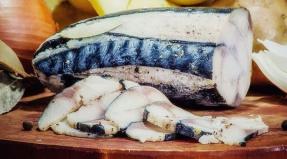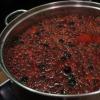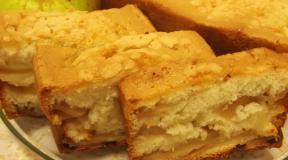Features of the preparation of Japanese rolls. How to make delicious rolls at home How to make different rolls at home
Every day, Japanese cuisine is becoming more and more in demand and popular. Their satiety, attractive appearance, exquisite and original taste does not leave anyone indifferent. Rolls can be eaten not only in a restaurant, but also prepared at home, which will cost less.
What are rolls, what products are needed for their preparation
Rolls are a traditional dish for Japan and Korea, sometimes they are also called sushi rolls. They are made with a variety of ingredients that can be combined and matched in different ways, each time creating a new and original dish.
To prepare this dish, a mat is required, with the help of which the rolls are rolled, as well as some products:
- rice vinegar;
- nori sheets;
- wasabi;
- soy sauce;
- pickled ginger;
- a fish;
- avocado;
- cucumber.

It is best to use only fresh products for making rolls. Rice, vinegar, sauce, ginger and wasabi can be bought separately in the store or in the same set, other products will have to be chosen at your discretion.
To prepare more exotic rolls, you can use several types of fish, caviar, mussels, octopuses, crabs, shrimps, sesame seeds, and various cheeses.
How to properly prepare rice for rolls
One of the main products in the preparation of sushi and rolls is a certain type of rice. It is being prepared using a special technology.
Ingredients:
- rice - 0.4 kg;
- 0.5 liters of water;
- rice vinegar - 4 tablespoons;
- 2 teaspoons of salt
- sugar - 1 tablespoon.
Calories per 100 grams: 342 kcal.

Preparing delicious rice for rolls is very easy if you follow the instructions and follow them completely.
- Pour rice into a sieve and rinse it under cold running water;
- Pour water into a saucepan, put the rice, cover and bring to a boil and let it simmer for 2 minutes, then remove the container from the heat and let the rice swell for 10 minutes;
- Remove the lid from the saucepan and let the rice cook until the end for 10 minutes;
- Pour vinegar into a saucepan, put sugar, salt, stir and heat;
- Put the finished rice in a plate, add the marinade to it and mix well.
Rice prepared according to this recipe turns out exactly as it should. Combined with algae, various ingredients, it will fully unfold.

A simple step-by-step recipe for rolls at home
Some of the tastiest and easiest to prepare are cucumber and shrimp rolls. They turn out to be delicate and refined, but at the same time very light, which will appeal to those people who prefer diet food.
Ingredients:
- 6 nori sheets;
- 0.25 kg of shrimp;
- 350 grams of cooked rice;
- 3 cucumbers;
- 1 tablespoon sesame seeds.
Cooking time: 30 minutes.
Caloric content per 100 grams: 156 kcal.

Cooking such rolls is a pleasure, since even the most inexperienced culinary specialist can cope with this activity.

Ready-made rolls will be appreciated by all family members, despite their simplicity, they turn out to be very tasty and unusual.
Rolls "Philadelphia" at home
For a person who has never tried sushi, it is best to start discovering the world of Japanese cuisine from the Philadelphia rolls. Thanks to their delicate, refined and balanced combination of products, these rolls are liked by everyone, without exception.
Ingredients:
- 450 grams of cooked rice;
- 0.6 kg of trout;
- avocado - 1 piece;
- 3 cucumbers;
- nori - 4 sheets;
- 0.3 kg of Philadelphia cheese.

Caloric content per 100 grams: 160 kcal.
The specified products are enough to prepare 6 blanks. This amount will make a whole set of 48 rolls, which will be enough for the whole family.

Despite some difficulties in preparing rolls, with a strong desire and diligence, everyone will learn how to make them.

How to cook Caesar rolls at home
Cooking delicious and ideal-shaped rolls is a task that not every novice cook can cope with. But with a strong desire and patience, this can be easily learned.
Ingredients:
- 0.4 kg of cooked rice;
- nori sheets - 4 pieces;
- fried chicken breast - 200 grams;
- sesame;
- 1 avocado
- 2 cucumbers;
- 100 grams of bacon;
- 100 grams of Grana Padano cheese;
- 10 0 grams of lollo-rosso salad.
Cooking time: 15 minutes.

Caloric content per 100 grams: 165 kcal.
Cooking Caesar rolls is a real pleasure, because, despite the multicomponent nature of the dish, everything in it is quite simple.
- Rice is boiled and brought to the desired state in advance, cooled a little and laid out on a sheet, sprinkled with sesame seeds. Nori is best laid out on a bamboo rug covered with cling film;
- Nori is covered with the free edge of the rug and turned over, and chicken breast, cheese, bacon, lettuce, and cucumber and avocado in the center are laid out on the reverse side;
- Form a roll, and grease the edge of the algae with water and fix;

This sushi is perfect for those people who like to experiment. Cheese, chicken, bacon and other ingredients create a rather delicate and harmonious taste that simply cannot be forgotten.
Home baked rolls
If you are tired of ordinary sushi and want to try something new and unusual, you should prepare baked rolls. This dish will appeal to all family members, both adults and children.
Ingredients:
- lightly salted salmon - 0.2 kg;
- hard cheese - 160 grams;
- nori - 4 sheets;
- 1.5 cups cooked rice
- cucumber - 2 pieces;
- 6 tablespoons of mayonnaise.
Cooking time: 15 minutes.
Calories per 100 grams: 148 kcal.

Baked rolls are a delicious and unusual dish that not all sushi lovers have tried. All ingredients are ideally combined with each other and create a delicate and harmonious taste.
- Rice is boiled, seasoned, cooled;
- Cucumbers are washed, if necessary, the skin is cut off from them and cut into strips so that their thickness is 0.5 centimeters;
- Put food film on the mat, on it, put a sheet of nori, on top - a layer of rice and gently turn the seaweed up;
- Put the chopped cucumber on top of the sheet, and wrap the roll so that the rice is on top;
- Cut the fish into small pieces and mix well with grated cheese and mayonnaise;
- Cut the rolls into 6 pieces, put on a baking sheet and top with a mixture of mayonnaise, fish and cheese;
- Bake for 15 minutes in the oven at 180 degrees.
Hot sushi is best served right away so that it doesn’t have time to cool down. Their taste will be a little unusual and piquant, but they will only benefit from this.

Rolls with egg pancake
To create not just rolls, but a real culinary work that will appeal to children and adults, anyone can cope with this. Such sushi is not only tasty and tender, but also has a presentable appearance, so they can even be served on a festive table.
Ingredients:
- 2 eggs;
- sugar - 0.5 teaspoon;
- nori - 2 sheets;
- soy sauce;
- cucumber - 1 piece;
- 40 grams of cream cheese;
- 60 grams of salted pink salmon;
- rice vinegar - 0.5 teaspoon.
Cooking time: 15 minutes.

Caloric content per 100 grams: 100 kcal.
Making sushi with egg pancakes is quite simple and takes a minimum of time. This dish is very light, but at the same time satisfying, so it is ideal for breakfast or lunch.

Sushi prepared according to this recipe always turns out to be tender and tasty. An egg pancake instead of rice brings an unusual flavor to this dish.
Making rolls at home is a real art that needs to be learned. It will never work to cook them perfectly, the first time, but with a great desire, patience, this art can always be learned.
- To cut the rolls, you must use a knife with a wooden handle and a well-sharpened blade;
- To prevent sushi from falling apart, it is best to use a bamboo mat, which will firmly compress the rice and filling;
- Products should always be fresh to make the dish tasty and healthy.
Rolls are a dish that spoils very quickly, so it is best to cook them before the actual meal. After 6 hours, they can deteriorate, and this is dangerous for human health and life.
During the preparation of the rolls, you can safely experiment with different fillings, add fish, red caviar, cucumbers, avocado, cream cheese, shrimp and other ingredients that you can only wish for.
Cooking options for several more options for rolls are in the next video.
Japanese rolls are a unique dish with an intriguing combination of sweet and sour rice, specific nori seaweed, crispy vegetables and fresh fish. Perfectly even pieces with a bright color scheme look appetizing, but it is not always possible to prepare a beautiful and tasty meal.
Rolls are healthy and low-calorie rolls, sometimes used in weight loss diets. At first glance, they are prepared simply, they do not require special skill. Why are there crooked pieces with scattered rice and an unpleasant taste? It is impossible to take them with chopsticks, being afraid to turn a unique dish into a banal garnish with vegetables! Observing how cleverly and quickly it turns out with sushi, not every culinary specialist pays attention to the technique of rolling rolls. He mistakenly assumes that uramaki or hosomaki are easier to make and more beautiful to serve than pancakes. How to properly cook Japanese rolls at home?
Rolls preparation technology
The taste and presentability of a Japanese dish largely depends on the skill of the sushi and the quality of the rice. You should be especially careful when choosing cereals for sushi, because it may not be long enough and with little stickiness. Finished grains do not absorb moisture well, they turn out to be boiled or too crumbly. Culinary experts recommend using the Nishiki or Yoshi variety. It is undesirable to buy a Vietnamese product because of its unpleasant specific smell.
Rice
 Cooking rice for rolls and sushi is a whole art! It is necessary to exactly observe the proportion and keep track of the time. It is better to steam the cereals in a rice cooker, but you can use a multicooker (set the "Stew" mode for 10 minutes, then switch to heating). If the product is damp, the next time you need to increase the amount of liquid.
Cooking rice for rolls and sushi is a whole art! It is necessary to exactly observe the proportion and keep track of the time. It is better to steam the cereals in a rice cooker, but you can use a multicooker (set the "Stew" mode for 10 minutes, then switch to heating). If the product is damp, the next time you need to increase the amount of liquid.
Cooking technology is simple:
- Rinse 1 kg of rice thoroughly in chilled water until it becomes completely transparent (it is more convenient not in a bowl, but in a colander);
- let the water drain (10 minutes is enough);
- pour rice into a dry bowl of a rice cooker, pour 1.2 liters of chilled water, sushi sometimes add a couple of drops of vegetable oil;
- cook for 25 minutes, then turn off the equipment and count down 10 minutes (the lid cannot be opened);
- prepare any wooden surface, remove the bowl from the rice cooker and turn it over (usually a thin dry crust forms on the bottom and side, so the rice will fall out on the board in one lump, like a head of cheese);
- wait 5 minutes for the cereal to cool slightly;
- using a plastic spatula, carefully remove the crust (you can pour it over with sauce and eat it), transfer the porridge to a plastic bowl or a special wooden basin;
- Weigh out 200 grams of cold rice dressing, spread over the entire surface until the porridge is cold;
- gently stir the rice with a spatula so as not to disturb its integrity, and leave to cool completely.
As the dressing is added, the porridge becomes a little thinner, but the warm grains will quickly absorb the flavorful sauce. The main component of the rolls will turn out to be not boiled, sticky, fragrant and with a pleasant aftertaste. After cooling, it is transferred to a non-metallic container, covered with a film, in which small holes are made. You can store it in the refrigerator, although it is more correct at room temperature for no more than 2 days. Perfectly cooked rice is the backbone of the Japanese dish's flavor palette.
How to make a savory dressing
 The rice sauce will add a sophisticated flavor to the dish. They take Mitsukan (rice vinegar) as a basis, throw in a lot of sugar (almost 2: 1) and salt. To make the liquid more fragrant, a small leaf of kombu seaweed and a couple of grams of lemon zest are often added. In order not to lose the specific sourness, it is advisable to bring the dressing to a boil, cool and strain. It is stored in the refrigerator for a long time, it turns out to be a yellowish tint and a slightly viscous consistency.
The rice sauce will add a sophisticated flavor to the dish. They take Mitsukan (rice vinegar) as a basis, throw in a lot of sugar (almost 2: 1) and salt. To make the liquid more fragrant, a small leaf of kombu seaweed and a couple of grams of lemon zest are often added. In order not to lose the specific sourness, it is advisable to bring the dressing to a boil, cool and strain. It is stored in the refrigerator for a long time, it turns out to be a yellowish tint and a slightly viscous consistency.
Nori is an important ingredient for rolls
The presentability of the rolls depends on the quality of the pressed algae (red). It is better to bypass the cheap options: during the cooking process, nori breaks or crumbles, it quickly shrivels and breaks under the rice. Culinary experts recommend buying grade A: the sheets are dense, with smooth edges, rich green color without a reddish or reddish tint. In the light, they practically do not shine through.

The sheets are lined with 7-piece lines that help cut the product into uniform (wide or narrow) strips. Nori is usually split in two, but whole plates are used to make large or hot rolls. In order not to accidentally tear them, it is better to use scissors or a sharp knife, although experienced sushi specialists easily fold the sheet in half, press it on the bend and tear it apart.
Nori is an excellent source of iodine, so do not get carried away with sushi so that the body does not have an excess of it. The product is stored in a tightly closed package or metal box. Due to moisture and steam, the sheets shrink, so during the preparation of Japanese rolls or felixes, the edges must be moistened with water very carefully. If there is not enough practice, it is better to seal the seams of the roll with several grains of rice.
Cooking delicious rolls is a real art!
The important components of the dish are ready, it remains to cut the filling into cubes (vegetables, raw or salted salmon) and discover the secrets of making rolls:
- It is advisable to cover the bamboo rug with cling film on both sides, carefully wrapping the edges. It should fit snugly against
mat (can be pierced with a toothpick to release air). - Put the rug on a flat surface, place the nori on it with the rough side up so that the grains do not slide off during the roll formation.
- So that the croup does not stick to your fingers, it is advisable to moisten your hands, or wear disposable cellophane gloves.
- Weigh out the rice (80-130 grams, depending on the type of roll) and place in the microwave for a couple of seconds. The beans should be warm, but not too hot. Place in the middle of the sheet and spread gently over the entire surface, especially on the sides. Do not press the grains against the algae!
- If the nori roll is on top (hosomaki or futomaki), when placing rice, you should step back 1 cm from the far side of the sheet. Spread the filling from the near edge. Wrap gently, slightly lifting and pressing the mat. Moisten an uncoated strip of nori with water and spin the roll completely. The seam of the product must not come loose.
- If there is rice (uramaki) on top, then a clean strip of nori should be left on the near side, next to you. From the far side, the grains should protrude 1 cm beyond the edge of the sheet. Sprinkle the groats with sesame or tobiko, lightly iron with the palm of your hand. Turn the seaweed over, put the filling on the edge. Raise the uncovered nori strip slightly, cover the vegetables, press down and roll. The seam will not be visible, because the croup will close it.
- Put the resulting roll on the board, cover with a rug and press down. Turn the product over to the other side, press down again with a mat, be sure to run your fingers along the entire length at the same time from above and to the sides. At this stage, you can form a square, round or triangular roll. If you cook "Philadelphia" or "Dragon", first lay out the fish plates, and then shape with a mat.
- In order for the roll to have smooth and beautiful edges, you need to press them with your palm, holding the product with a rug. It should turn out to be perfectly even, the grains with fish should fit snugly to the roll.
- In order not to disturb the fish top, the Japanese roll can be covered with foil. Moisten a sharp knife in cold water, visually divide the product in half and cut quickly. Wash the blade, put the pieces together and divide into 3 parts. As a result, 6 triangles or squares should come out. When cutting, perfect edges can be damaged, so the pieces are lined up and pressed again with a rug. The roll is ready.
- Often the ends of the product come out uneven, so before dividing the roll, ugly edges can be cut off. The pieces should be the same height and dense. It is desirable that the fish plates completely or half cover the sides of the product.

How to Submit a Japanese Artwork
Rolls look great on black Asian plates, but you can use transparent dishes. The pieces are laid out in different ways, based on the type of product. "Dragons" usually wriggle like a snake, "Philadelphia" and "California" are collected in a checkerboard pattern. They form a slide from large futomaki and decorate with a neat bunch of mixed salad. Japanese rolls with eel, "Green" and "Yellow Dragon" are poured over unagi and sprinkled with sesame seeds. Sets (assorted) rolls look especially beautiful. However, it is difficult to combine several products to get a unique picture, and it was convenient for guests to eat from all sides.

You need to lay out the barrels in even rows, as if under a ruler. Diagonals and scattered pieces are discouraged. There should be room on the plate to complement the dish with delicious foods:
- Pickled ginger is preferable to use white, because it is without dye. First, it is slightly squeezed out so that the excess marinade is gone, a slide is formed and, as it were, put on a plate. With beautiful root petals, it is easy to neutralize the aftertaste of an eaten piece and fully enjoy the taste of another.
- Many people mistakenly assume that the pale green wasabi powder neutralizes harmful microorganisms that may be found in sea fish. Unfortunately, we sell a tinted horseradish seasoning, and the real valuable root is too expensive and is considered a delicacy. However, the pseudo product is quite sharp, so it is more convenient to knead it with your hands, wearing gloves, preferably near a hood or an open window. Put a spoonful of wasabi in a bowl, add a little cold boiled water and mix thoroughly. If the mixture turns out to be thin, you can throw in more powder, but it is worth remembering that during storage in the refrigerator, the mass is slightly compacted. Place the green mass in a small pastry bag, plant on a flower-shaped plate. If you thicken the wasabi, it is better to form a cube or leaf.
- Soy sauce is served separately in a gravy boat. If it is too saturated and salty, it can be diluted with water and brought to a boil. Mirin and sake will add an interesting flavor. Wasabi is often added to the sauce during meals.
Sometimes a plate with rolls is decorated with a lemon wedge, and a damp and microwave-heated towel (mistakenly) is served on a special wooden stand. They wipe their hands before and after a meal, only after use it is customary to carefully smooth it.

You can store the rolls in the refrigerator, but no more than half an hour, after wrapping it with cling film. Every minute their taste and appearance is rapidly deteriorating, rice and vegetables are saturated with other smells and lose their individual aftertaste. Culinary experts are sure that the product should be eaten immediately after cooking, while the rice is not too cold and the filling has not yet warmed up.
How to properly prepare the components of the rolls?
Fragrant rice and specific algae are the background for creating a sophisticated taste range. The dish must be completed with a bright bouquet of filling. Food must be fresh, colorful and properly prepared.
Vegetables and fruits
The taste of the roll depends on the cut shape of the components. They can be chopped into thin and long straws or neat, even sticks. Hard root vegetables and fruits (daikon or green mango) are best crumbled as small as possible. Fresh cucumber must be peeled from the green peel, cut into thin slices in full length, wrap a roll or make a felix. For the filling, the juicy center with unripe seeds is often removed, then the dish turns out to be more crunchy.

The avocado should be moderately ripe. For the back of the "Green Dragon", the fruit is cut into slices exclusively with the tip of the blade, without lifting the knife from the board. With your left palm, you need to lightly press the semicircular pieces and pull upwards, and then gently lower them down. You should get a ladder. Use the blade of a knife to pick up an avocado and place it on the back of the "dragon". The fruit can be cut with a housekeeper, only each piece must be laid out immediately on the roll.
Tiger chrimp
They are often used to make "Yellow Dragon", hot rolls and sashimi, and they are cooked in a special way. Seafood (without a head) is peeled from the shell, leaving 2 plates at the end of the tail, and the intestinal thread is removed from the back. To prevent the shrimps from curling into an arc during cooking, they are put on long wooden skewers, starting from the head. Throw in boiled unsalted water for a minute, and then immediately into ice. The meat is tender and juicy. The shrimp is removed from the skewer, an incision is made along the entire length with a sharp knife (from the side of the abdomen and to the back, without cutting in half). Then they gently straighten, remove uneven places (usually near the head) and give a beautiful shape. The product can be stored for one and a half days.

Tempura shrimp is often added to the roll. In this case, raw seafood is strung on a skewer, dipped in thick batter based on a special flour mixture, eggs and water, and deep-fried until golden brown.
Fish is an irreplaceable component of rolls
Fillet of fresh tuna, salmon, lakedra should be dense, elastic, without loose and exfoliated fibers. Any unpleasant smell, dull color and opaque juice in the package indicates the spoilage of the product. It is better to buy fish chilled and whole or frozen fillets. After thawing, the product is stored in a dry container for no more than 24 hours.
For the filling, the fish is cut into even cubes. To get beautiful thin plates for the top of the roll, the blade must be held parallel to the fillet. Make a small incision and smoothly slide the knife from right to left, holding the layer with all your fingers. This makes it easier to control the thickness of the piece.

Smoked eel is freed from excess sauce, divided into two parts along the back. Be sure to check for small cartilages that have not softened to the end during the manufacture of the product (usually they are on the sides). For the back of the "Yellow Dragon" roll, remove the golden upper part (obliquely to the skin at an angle of 30 degrees). For sushi, eel is cut diagonally and at a slight incline along with the skin. You should get 12 gram pieces (with sharp edges), a bit like petals.
Shiitake
It is impossible to forget the enchanting taste of shiitake rolls! Dry mushrooms are poured with water for 5 hours to swell, and washed. Cook until tender, cool, free from liquid, cut into thin slices. Fill a preheated pan with prepared shiitake, sprinkle with sugar and heat (you can season with black pepper along with soy sauce). Sweetish taste with specific notes will exquisitely complement almost any vegetable roll.
Video recipes
A professional chef prepares several types of rolls in a regular home kitchen. Explains the rules for cooking rice, rolling rolls. And as a bonus prepares a couple of Japanese soups, including.
Japanese dishes attract with their simplicity, beauty and healthiness. However, not knowing about the intricacies of making rolls, it is impossible to create an exquisite "Philadelphia" or a sophisticated "Green Dragon" at home.
Hello everybody! Do you want to know how to cook rolls correctly? Today I will show you how to prepare simple thin rolls with one filling (Hosomaki). And for example, let's prepare rolls with Sake Maki salmon. Below you will see a step by step photo recipe as well as a video recipe.
There are several types of rolls: thin simple rolls (Hosomaki), thick complex rolls (Futomaki) and rice-sided rolls (Uramaki). Thin rolls are prepared with one filling, thick rolls with several fillings, and examples of Uramaki rolls are "Philadelphia", "Canada", etc. The most important thing to remember is that rolls are not rolls at all !!! Since the main mistake of all those who start preparing sushi is that they roll the rolls "snail".
In this photo there is one "correct" roll without a "snail", and the second with a "snail":

So, let's see why we got one roll with a "snail"? And let us consider this using the example of the simplest thin rolls with one filling "Syake Maki":
Take half a Nori leaf and a whole leaf.

Put the sushi rice on the Nori sheets, leaving an empty 1-1.5 cm strip of nori at the far end for gluing the roll.

Now put about the same amount of filling in the middle of the rice, in our case salmon. Of course, I could not attribute it to the roll so cruelly and put a little more fish on Nori's whole sheet)))

Now you need to twist a roll from half a sheet. To do this, raise the near edge of the mat, and gently holding the filling with the other hand, connect the upper edge of the nori with the lower one in the place where the empty strip begins. You should have a "tail" of nori, it is he who glues the roll.
You will not be able to repeat the same thing with a whole sheet of Nori, and depending on the thickness of the rice layer, you will get one or two extra Nori turns. This is what is called a "snail".




Some of you will of course say: Who cares, with or without a snail? It's delicious anyway !!! Rolls-snails prepared in this way lose not only their harmonious appearance, their simplicity and beauty, but also affect the taste of the roll, since an excess of rice and algae will not allow you to really feel the taste of the filling, in such a roll you will only feel the taste of rice and seaweed and only slightly taste the filling itself.
So, for the preparation of the simplest thin rolls with one filling (Hosomaki), half a sheet of Nori is needed. If you can't roll half a Nori sheet, then thin out the rice layer or reduce the amount of filling. That is, if you want to cook thin rolls, then you need half a sheet of Nori, and if you want a little larger rolls, then cook them from 2/3 of the sheet. Uramaki rolls are also made from half a Nori sheet. But for the preparation of thick complex rolls with several fillings (Futomaki), you need to take 2/3 of a Nori sheet or even a little more. Next, I will show in detail how to properly prepare rolls with salmon "Syake maki" (thin simple rolls "Hosomaki").
Step-by-step photo recipe for making rolls with salmon "Syake Maki":
We need:
- sushi rice (Japanese, round grain) - 350 gr
- water - 360 ml
- ready-made sushi seasoning (or rice vinegar, sugar and salt) -80-100 ml
- dried seaweed nori
- lightly salted or fresh salmon (trout or salmon)
- bamboo mat for making rolls (Makisu)
- cling film

So, first we need to cook rice. (Detailed description: How to cook sushi rice.
Now you need to prepare all the ingredients for the sushi.
Tip: Since the rice should be warm during sushi cooking and so that it does not cool down while you cook all the ingredients, I advise you to go through all the ingredients while the rice is being cooked.
Prepare Nori sheets. Of course, you don't need to cook them)) I meant that for our roll we only need half a whole sheet or 2/3 of a sheet. Sometimes I use half a sheet, and sometimes I use 2/3 of a sheet.
Take the whole Nori sheet.

And cut it in half.

From one of these halves of a Nori leaf, we will prepare rolls with salmon "Syake maki".

Wrap the Makisu bamboo mat in plastic wrap. You can buy yourself one single bamboo mat for making rolls "Makisu" and just wrap it in regular plastic wrap before each use and use it as much as you like and it will always be clean. And after using it you don't even need to wash it, but just remove the film and that's it !!! I wrap the mat in foil 5 times so that it does not unfold for sure)) I did not know this before and used a mat without a foil, after using it I thoroughly washed it, but still there were particles of rice, caviar, sesame seeds and I had to buy a new one. But now I always use cling film and I advise you too !!!


Now cut the fish into slices of equal thickness.





So, we have all the ingredients prepared and this is how they should look)

Now let's start making rolls with Sake Maki salmon. To prepare the simplest thin Hosomaki rolls, half a standard Nori sheet is enough. But if it seems to you that half is missing, it is better to thin the layer of sushi rice a little thinner or reduce the amount of filling. But if you want to make the roll thicker, with more rice and fish (or other filling), then you need 2/3 of a Nori sheet.
Take a bamboo mat "Makisu", on it place half a sheet of Nori, smooth side down (rough side up), on the part of the mat closest to you.

Now we need rice for sushi and cold water, it is advisable to put a few slices of lemon in it.

We spread the rice on a Nori sheet in an even thin layer (be sure to moisten your fingers in water each time before taking a part of the rice, otherwise the rice will stick to your fingers), leaving an empty strip of nori at the far end of 1-1.5 cm. empty edge so that the rice does not stick out of the rolls at the gluing site.
We just spread the rice without crushing it with our fingers. Rice will need about 70 gr.

Then put a thin slice of salmon in the middle of the rice. A thin slice - no more, otherwise your roll just won't stick together. Salmon or other filling for thin rolls of Hosomaki will need about 20 grams. And if you are cooking not from slightly salted fish, but from fresh, then in the middle of the rice, before putting a slice of fish, put a thin strip of Wasabi paste (just a little bit, this is needed for disinfection, so as not to be poisoned by raw fish). And in general, when you eat raw fish rolls in a restaurant, always eat wasabi rolls to protect yourself! You don't know how fresh the fish are in the rolls that were served to you.

Now we need to twist the roll, tight enough so that it does not lose its shape when cutting. To do this, lift the near edge of the mat, and gently holding the filling with your other hand, connect the upper edge of the nori with the lower one in the place where the empty strip begins. You should have a "tail" of nori, it is he who glues the roll.





Here we have such a thin roll of "Hosomaki")

It remains only to cut our roll into 6-8 parts. In general, thin “Hosomaki” rolls are cut into 6 parts, and thick “Futomaki” and “Uramaki” rolls into 8 parts. For this, our KNIFE MUST BE VERY SHARP, otherwise the roll will fall apart and lose its beautiful appearance when cutting. It is advisable to sharpen the knife before cutting! And so that the roll does not fall apart, be sure to moisten the knife in cold water before each cutting and remove the rice and cheese particles from the knife !!! For convenience, you can wrap the roll in cling film and cut with it, or you can without it, this is more convenient for you)
To do this, first cut the roll exactly in half. Then place both halves next to each other. And cut the roll into 6, that is, each half into 3 parts.
That's it, our rolls with salmon "Syake Maki" are ready !!! Put them on a beautiful Japanese plate and enjoy!











Simple thin "Hosomaki" rolls are very easy to prepare, the main thing is to understand what size of Nori sheet is needed for them and how much rice and filling and that's it))
The cooking process does not take much time, and the result will delight the family and pleasantly surprise the guests. Recipes for sushi and rolls are very diverse, and everyone will find what they like. This exotic culinary masterpiece can be prepared from fish, meat, shrimp, squid, crab sticks, canned food and herbs, combined with rice, which is placed inside. It serves as a binding ingredient and due to it, the finished dish retains its shape.
The five most commonly used ingredients in recipes are:
For vegetarians, there are many options with vegetables and fruits that taste like fish products. The secret of the unique aroma of this dish lies in the algae in which the roll is wrapped. And in a traditional combination with soy sauce and wasabi, this treat will not leave anyone indifferent. Among the recipes, there are many baked options. They are prepared in much the same way as regular sushi and rolls, but at the end they are poured with sauce and briefly sent to the oven, which gives an amazing aroma. Such food is served with a regular family dinner and a festive table.
Cooking rolls at home is a very real task if you arm yourself with the necessary "tools". We need a mat (a special mat for rolling rolls), a sharp knife, cling film, as well as some products. Having purchased everything you need in advance, you can start making a popular dish.
We will use a simple recipe for making rolls with a classic combination of fish, cucumber and cream cheese. This type of filling can be called the simplest, most common and quite affordable. So, let's find out how to cook rolls at home.
Ingredients: 
- round grain rice - 1 glass;
- water (for cooking rice) - 1.5 cups;
- dressing for rice - about 50 ml;
- red fish - 150 g;
- cucumber - 1-2 pcs.;
- nori sheets - several pieces;
- cream cheese - 150 g;
- green onions (optional) - a few feathers.
Cooking rolls at home recipe with photo
How to cook rolls at home
- Any recipe for making rolls begins with cooking the main component - rice. We remind you that the technology of making rice in Japanese cuisine is different from the method we are used to. The washed rice grains are boiled with a tightly closed lid over moderate heat until the moisture has completely evaporated, and after boiling, they must be impregnated with a special dressing. Detailed instructions are described in the article "".

- Next, we proceed directly to the formation of the Japanese dish. To do this, wrap the mat with cling film, cut the nori sheets in half. Spread the rice, which has cooled to room temperature, in a thin layer over the rough surface of Japanese algae. We leave a free space of about 1 cm on one edge, and on the other, on the contrary, "step in" with rice grains beyond the border of the nori leaf. Periodically moisten your palms with water to prevent sticky rice from sticking to your fingers.

- Gently take the nori by the rice-free edge and turn it over to the other side. Now we put several thin slices of cucumber on a smooth surface. We distribute 1-2 tbsp. tablespoons of cheese. For a change, you can add a feather of green onions to the filling.

- We cut the fish in plates, removing all large and small bones. You can cook rolls at home with salmon, lightly salted salmon, trout and any other red fish - there are no restrictions here. Place some bright fish pieces to the rest of the filling.

- Now we are facing the most crucial stage - folding our blank into a tight roll. We start at the edge of the nori, which has no rice on it. Raise the mat, covering the entire filling with a portion of the nori sheet, then make another turn. As a result, you should get a monotonous, moderately tight roll. For a beginner in Japanese cuisine, this process may seem complicated, but there is nothing incomprehensible here: only practice is needed.

- With a mat we give the roll the desired shape (round or square), and then cut into 6 or 8 pieces. It is important to remember that only a sharp knife is suitable for this: it is almost impossible to beautifully cut the rolls with a dull blade.

- You can use sesame seeds, tobiko caviar and more to give the rolls a presentable look. Serve the rolls with soy sauce in a small bowl. The Japanese dish will be complemented by pickled ginger and a small portion of the hot sauce "Wasabi".
 As you can see, the recipe for making rolls is quite affordable. The main thing here is to practice rolling rolls, but otherwise everything is extremely simple. Experiment with the filling and decoration for a change. Enjoy your meal!
As you can see, the recipe for making rolls is quite affordable. The main thing here is to practice rolling rolls, but otherwise everything is extremely simple. Experiment with the filling and decoration for a change. Enjoy your meal!
Read also ...
- Recipes for making coffee with ice cream at home
- Strawberry panna cotta - a classic of world culinary What is panna cotta with strawberries
- Cream of curd cheese for cake - the best recipes for impregnating and decorating dessert
- Profiterole recipe and three original custard recipes Protein cream for profiteroles


















